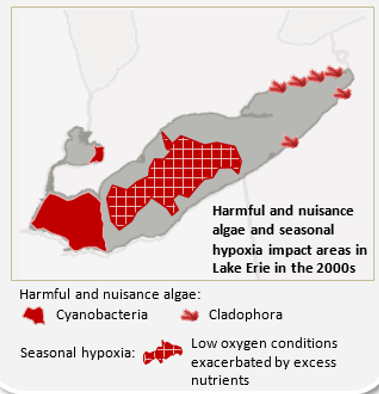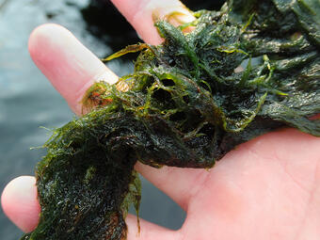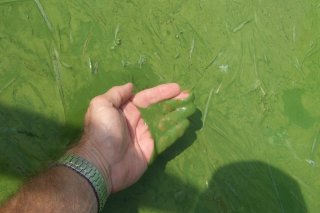About the Nutrients Annex (Annex 4)
On this page:
- Great Lakes Water Quality Agreement Commitments
- Phosphorus targets to address eutrophication
- How were the new targets developed?
- How are the new targets being implemented?
Great Lakes Water Quality Agreement Commitments
The Great Lakes Water Quality Agreement (GLWQA) is an agreement between the U.S. and Canada to restore and protect the waters of the Great Lakes. It’s a framework for identifying binational priorities and actions that improve water quality.
Eutrophication occurs when the environment becomes enriched with nutrients, increasing the amount of plant and algae growth. EPA’s National Coastal Condition Assessment of the Great Lakes shows that eutrophication is a persistent problem in Great Lakes nearshore waters, and that Lake Erie experiences the most eutrophication, with 67% of the nearshore waters in fair or poor condition in 2015.
Under the Nutrients Annex (Annex 4) of the GLWQA, the U.S. and Canada committed to develop U.S. and Canadian Domestic Action Plans (DAPs) for phosphorus reductions in each country. Reduction targets were developed by the Annex 4 Nutrients Subcommittee and adopted formally by the U.S. and Canada in February 2016. Five-year DAPs were issued in 2018 and are up for renewal in 2023.

Phosphorus targets to address eutrophication

The three key eutrophication issues to be addressed in Lake Erie are:
- in the western basin, blue-green algae (cyanobacteria) blooms and associated toxins,
- in the central basin, seasonal hypoxia – areas of low oxygen, and
- in the eastern basin, excessive growth of nuisance algae, primarily Cladophora, on the lake bottom.
In 2016, the U.S. and Canada adopted the following phosphorus reduction targets to address these issues for Lake Erie:
- A 40 percent reduction in total phosphorus entering the western and central basins of Lake Erie to achieve an annual load of 6,000 metric tons to the central basin.
- A 40 percent reduction in spring total and soluble reactive phosphorus loads from the Maumee River in the U.S.
- A 40 percent reduction in spring total and soluble reactive phosphorus loads from the following additional watersheds where algae is a localized problem: in Canada, the
-

Hand holding a clump of Cladophora. Source: USGS Thames River and Leamington tributaries; and in the U.S., the River Raisin, Portage River, Toussaint Creek, Sandusky River and Huron River (Ohio).
No phosphorus reduction targets have been set for the eastern basin. This is because Cladophora growth is influenced by many other factors, including light, substrate type, and invasive mussels. EPA and ECCC are in agreement that nutrient reduction targets may not be effective to address Cladophora impacts in the eastern basin.
The in-lake phosphorus concentrations expected to result from the recommended phosphorus load reductions are within the ranges associated with desired nutrient levels in each of the lake’s basins. This is an important consideration because too little nutrients could put the fisheries at risk.

| Basin | Interim Objectives Great Lakes Quality Agreement Annex 4, Section C | Expected Outcome from Implementation of Proposed Load Reduction Targets |
|---|---|---|
| Lake Erie (Western Basin) | 15 µg/L | 12 µg/L |
| Lake Erie (Central Basin) | 10 µg/L | 6 µg/L |
| Lake Erie (Eastern Basin) | 10 µg/L | 6 µg/L |
How were the new targets developed?
The process to review and evaluate the phosphorus targets for Lake Erie began in 2013. Modeling experts from the U.S. and Canada used nine different computer simulation models to correlate changes in phosphorus levels with levels of algal growth. By comparing the results of these models, the GLWQA Nutrients Annex Subcommittee was able to arrive at phosphorus load reduction targets, calculated using 2008 data. 2008 was selected due to the quality of the data available for that year and because conditions in Lake Erie in 2008 were considered representative of an “average” year.
The subcommittee’s recommendations are based on information contained in the following factsheet, technical report, and consultation summary:
- Factsheet: Recommended Binational Phosphorus Targets to Combat Algal Blooms
- Annex 4 Objectives and Targets Development Task Team Final Report to the Nutrients Annex Subcommittee
- Annex 4 Final Multi-Modeling Report
- Consultations on the Recommended Binational Phosphorus Reduction Targets for Lake Erie: Summary of Comments (PDF) (2pp, 22.7K)
How are the new targets being implemented?
With the adoption of new binational targets in place, the governments worked with partners and stakeholders to develop domestic action plans (DAPs). These plans, which outline strategies for meeting the new targets in specific jurisdictions and watersheds, were published in 2018. In 2019, the GLWQA Nutrients Annex Subcommittee published the Lake Erie Binational Phosphorus Reduction Strategy, a companion document to the DAPs.
The strategy describes the framework to achieve 2016 binational phosphorus reduction targets. The strategy has four components:
- An updated assessment of environmental conditions to guide lake-wide nutrient management in Lake Erie;
- A summary of the process used to develop the 2016 targets and allocate load reductions between the U.S. and Canada;
- Binational priorities for implementation of measures to manage phosphorus loading, including the identification of watersheds that are a priority for nutrient control and binational priorities for research and monitoring; and
- A description of how progress will be tracked using an adaptive management approach.
To read the full strategy, visit:
Learn more about DAPs, visit:
